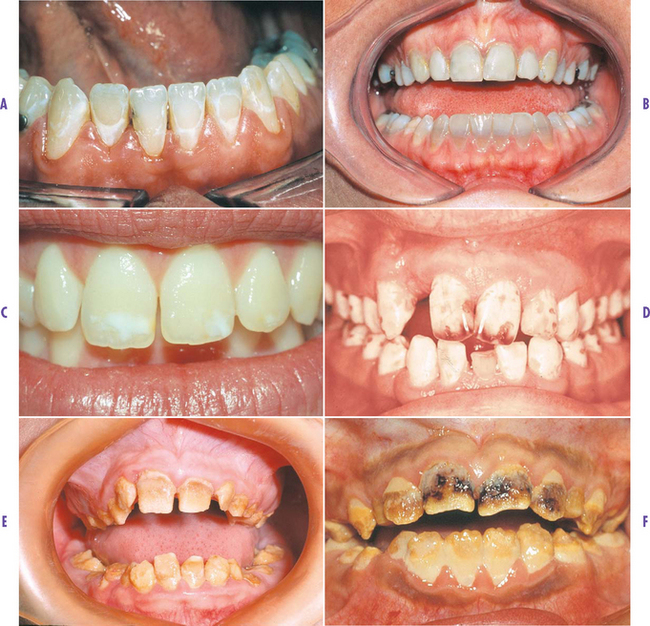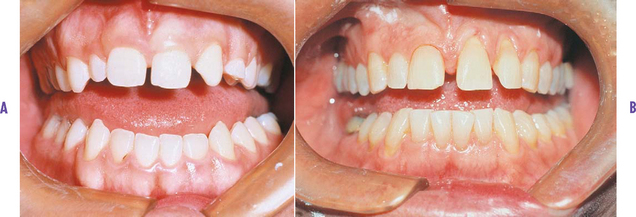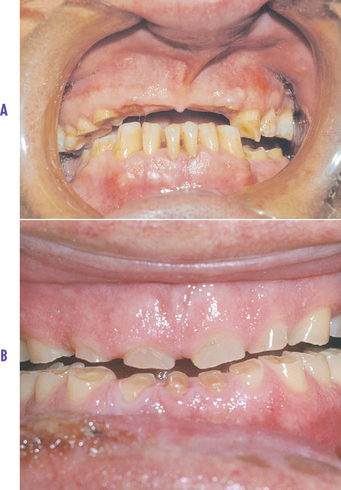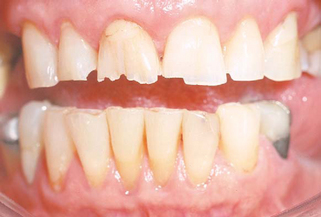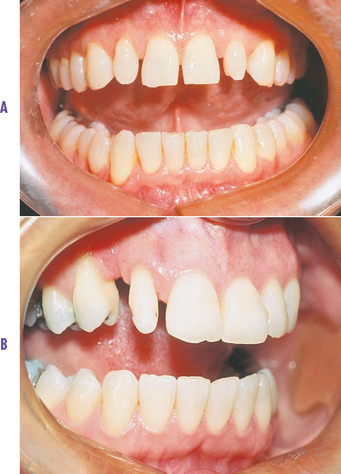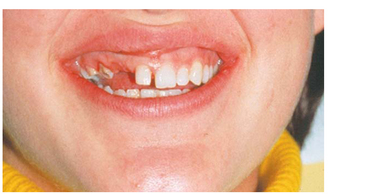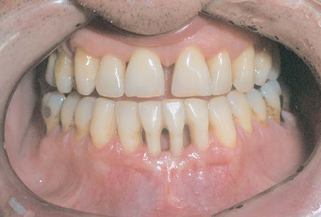CHAPTER 8 Esthetic Dentistry
Cosmetic Dentistry; Improving Your Smile
Most people prefer to appear “normal” in all ways, and they want their appearance to be acceptable to their friends and associates. When clothed, very few portions of the human body are observable to the public. National surveys have shown that on first meeting, the most observed portions of the body are the eyes and teeth (smile). The head and face are nearly always in view. The mouth and teeth, combined with the eyes, are the major features of facial expression. Deformed, diseased, or abnormal facial appearance can contribute to poor or misinterpreted expression and to low self-esteem. Your mouth is highly important to you, well beyond the obvious function of eating.
WHAT YOU SEE OR FEEL
Conditions, Signs, or Symptoms Related to Esthetic Dentistry
1. Discolored Teeth (Dark, Light, Spotted, Mottled, Striated)
Many conditions cause teeth to be discolored (brown, gray, orange, blue, green, white, yellow, etc.) (Fig. 8.1). Causes of discoloration include chemicals ingested during the early years of life, force or injury to the primary (baby) teeth that harm the developing permanent teeth, excess fluoride ingested during the first few years of life, drugs taken for various early-childhood diseases, metallic fillings giving color to the tooth, external stains caused by foods and drinks, and many other factors.
Persons with discolored teeth have some of the following treatment alternatives:
2. Spaces Between Teeth (Diastemas)
(Fig. 8.2). In some cultures, spaces between teeth are considered acceptable. In other cultures, spaces are not the “normal” appearance, and people want to eliminate them. These spaces are caused by teeth that are too small in relation to the size of the jaws; past removal of a tooth, causing drifting or spacing of adjacent teeth; lack of development of some teeth; orthodontic movement that did not completely close spaces; tight muscle attachments (frena) that keep teeth from coming together; and other factors.
Some spaces can be closed easily, while other spaces are more difficult to eliminate. All spaces between teeth can be eliminated if the patient sincerely desires that goal. The more common treatment alternatives for spaces between teeth include the following:
3. Worn Teeth
(Fig. 8.3). We all cause wear of our natural teeth throughout life. Researchers estimate that normal chewing wears natural teeth a little more than the thickness of a human hair per year. Such normal wear will not be visually evident for many years into life. However, as many as one third of the population wear their teeth significantly more than normal. These people brux or clench their teeth together, grinding them excessively. They will commonly wear their teeth many times faster than normal, rapidly deteriorating their appearance and function. Some persons may wear their teeth so much that they appear to have no teeth at all when they smile.
4. Fractured Teeth
(Fig. 8.4). In some countries, as many as one out of two children break a front tooth during childhood. This situation is usually very upsetting to parents and can impair the child’s appearance. Also, tooth fractures are not uncommon in adults. If the tooth fracture is into the dental pulp (nerve), root canal therapy (p. 40) is usually necessary before one of the treatments described below is accomplished. If the tooth fracture is below the gum, contouring of the gum tissue by gingivectomy (p. 135) may be necessary before upgrading the appearance. Only a few teeth are fractured to the degree that they must be removed, which creates a space that will need to be restored (p. 140).
One or more of the following treatment alternatives are possible for a fractured tooth:
5. Irregularly Shaped Teeth
(Fig. 8.5). Various conditions cause irregularly shaped teeth. They include injury to the primary (baby) teeth, which could deform the underlying permanent teeth; genetic disorders; diseases of the child or prenatal diseases of the mother during tooth development; and others.
6. Display of Too Much Gum Tissue
(Fig. 8.6). A gummy smile is not uncommon. It is usually caused by a disproportion of the facial soft tissues (gums) and underlying bone tissue. The result can be an unpleasant appearance and an unhappy person. What can be done? The following are alternatives:
7. Display of Too Much Tooth Root Surface
(Fig. 8.7). As life progresses, the gum tissues recede, and more root surface is displayed during smiling. The root surfaces usually contain more brown pigments, and this difference is often unattractive. Additionally, teeth become narrower the farther they are exposed up the root, and this narrow portion is displayed after gum recession and creates unattractive spaces. Such conditions are common after age 50, but fortunately they can be corrected by one or more of the following alternatives:
Stay updated, free dental videos. Join our Telegram channel

VIDEdental - Online dental courses


